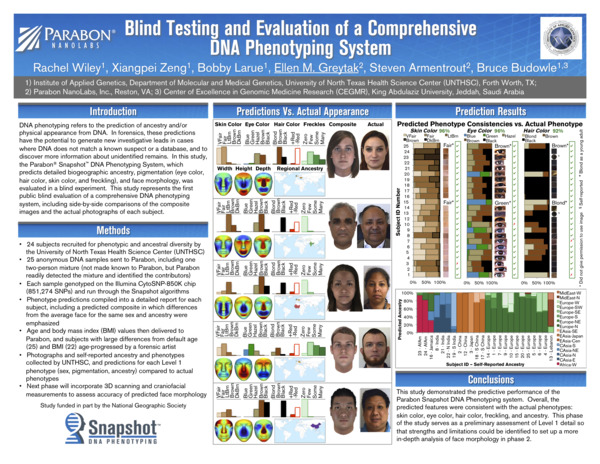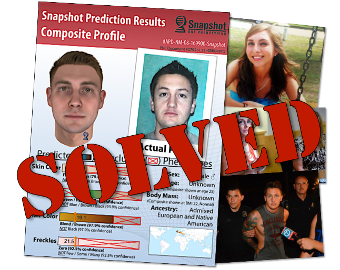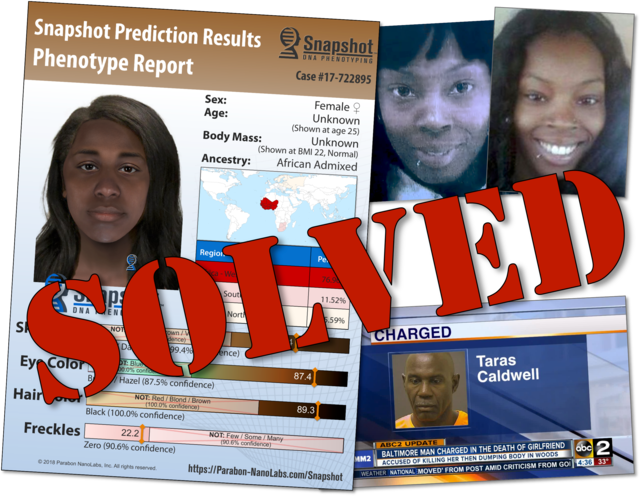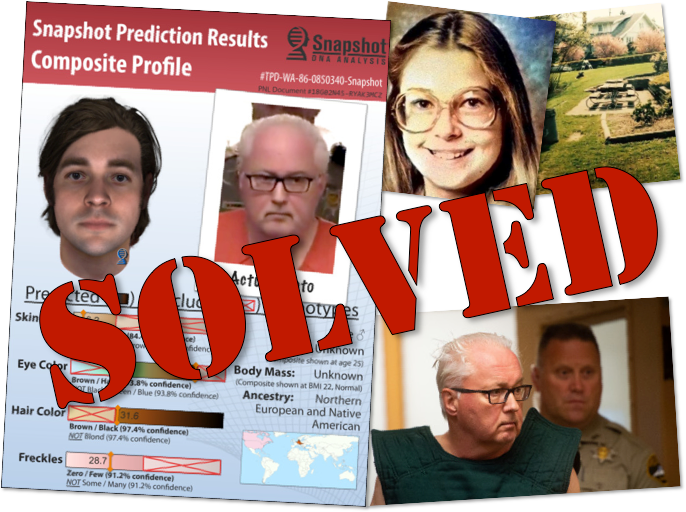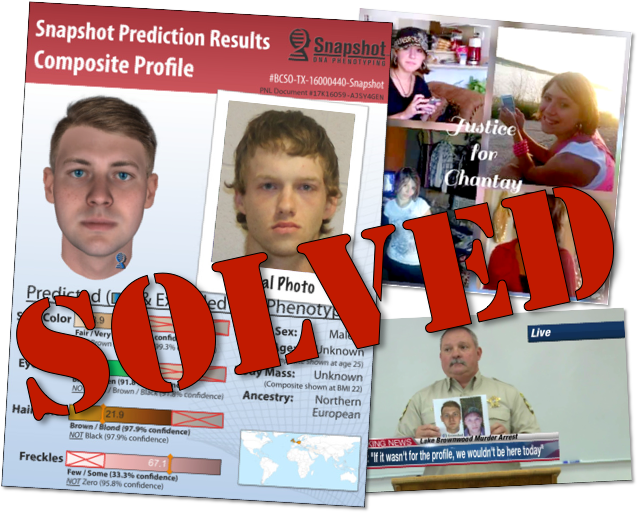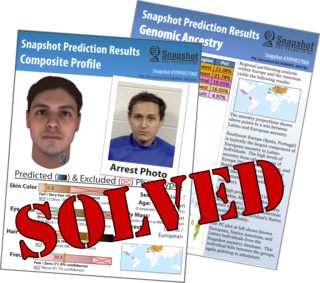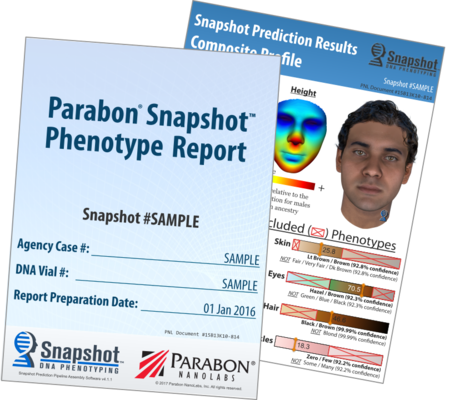The Snapshot DNA Phenotyping Service
DNA Phenotyping is the prediction of physical appearance from DNA. It can be used to generate leads in cases where there are no suspects or database hits, to narrow suspect lists, and to help solve human remains cases.
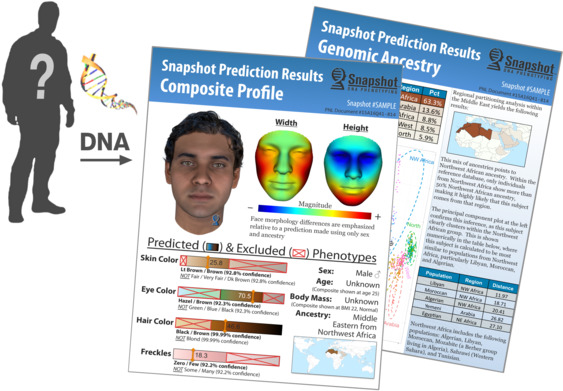
DNA carries the genetic instruction set for an individual's physical characteristics, producing the wide range of appearances among people. By determining how genetic information translates into physical appearance, it is possible to "reverse-engineer" DNA into a physical profile. Snapshot reads tens of thousands of genetic variants ("genotypes") from a DNA sample and uses this information to predict what an unknown person looks like.
Using deep data mining and advanced machine learning algorithms in a specialized bioinformatics pipeline, Parabon — with funding support from the US Department of Defense (DoD) — developed the Snapshot Forensic DNA Phenotyping System, which accurately predicts genetic ancestry, eye color, hair color, skin color, freckling, and face shape in individuals from any ethnic background, even individuals with mixed ancestry.
Because some traits are partially determined by environmental factors and not DNA alone, Snapshot trait predictions are presented with a corresponding measure of confidence, which reflects the degree to which such factors influence each particular trait. Traits, such as eye color, that are highly heritable (i.e., are not greatly affected by environmental factors) are predicted with higher accuracy and confidence than those that have lower heritability; these differences are shown in the confidence metrics that accompany each Snapshot trait prediction.
How DNA Phenotyping Works
Whereas traditional DNA forensics matches STRs from a sample to a known suspect or a database, DNA phenotyping can generate new leads about an individual, even if they have not previously been identified in a database. DNA phenotyping takes advantage of modern SNP technology to read the parts of the genome that actually code for the differences between people.
The Snapshot DNA Phenotyping System translates SNP information from an unknown individual's DNA sample into predictions of ancestry and physical appearance traits, such as skin color, hair color, eye color, freckling, and even face morphology. Each phenotype prediction is made with a measure of confidence, including those that can be excluded with high confidence.
SNP Technology
Recent advances in genomic technology have made it practical and affordable to read the sequence of millions of pieces of DNA from a small quantity of sample. This data captures a large proportion of the genomic variation between people and thus contains much of the genetic blueprint that differentiates people's appearance. These SNP genotypes can then be paired with phenotypes from thousands of subjects to create a genotype-and-phenotype (GaP) dataset for analysis.
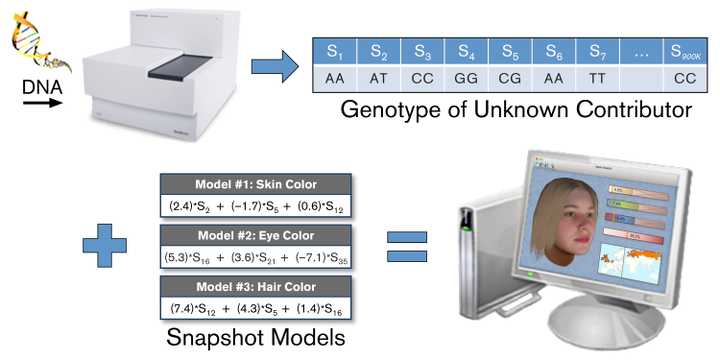
Using genomic data from large populations of subjects with known phenotypes, Parabon's bioinformatics scientists have built statistical models for forensic traits, which can be used to predict the physical appearance of unknown individuals from DNA.
Data Mining
Beginning with large GaP datasets containing genetic information and measures of phenotype for thousands of subjects, Parabon's bioinformatics team performs large-scale statistical analysis on hundreds of thousands of individual SNPs and billions of SNP combinations to identify genetic markers that are associated with a trait. This mining process can take weeks of compute time running on hundreds, sometimes thousands, of computers. In the end, those SNPs with the greatest likelihood of contributing biologically to the trait's variation are selected for potential use in predictive models.
Data Modeling
In the modeling phase, Parabon's scientists use machine learning algorithms to combine the selected set of SNPs into a complex mathematical equation for the genetic architecture of the trait. A new, unknown individual's SNP data can then be plugged into this equation to produce a prediction of the trait in that individual.
Model accuracy is assessed by making predictions on new subjects with known phenotypes ("out-of-sample predictions"). By comparing predicted versus actual phenotypes, Parabon scientists are able to calculate confidence statements about new predictions and, more importantly, exclude highly unlikely traits. For example, if 99% of brown-eyed people have an eye color prediction value greater than 2, then we can have very high confidence that a prediction of 1.5 most likely did not come from a brown-eyed person.
The final models are calibrated with all available data before being installed into the Snapshot production service that is used to generate phenotype predictions for investigators.
Snapshot Success Stories
Snapshot has been used by hundreds of law enforcement agencies around the world to help generate leads, narrow their suspect pools, and solve human remains cases, in both active and decades-old investigations.
- Featured Case Summaries: Read detailed case descriptions, including how Snapshot helped solve the following cases:
-
Just before noon on 11 September 2008, Diane Marcell returned to her home in Albuquerque, NM, to meet her daughter, Brittani Marcell, for lunch. Brittani, then 17 years old, had driven home from her nearby high school. Upon entering her home, Diane found Brittani lying on the floor, covered in blood. A male subject, unknown to Diane, was standing near Brittani holding a shovel.
Startled, he dropped the shovel, ran into... More
On Wednesday 14 June 2017, members of the Anne Arundel County Police Department responded to a call reporting that a body had been found in the area of East Ordnance Road and East Avenue in Glen Burnie, MD. Upon arrival, officers located badly decomposed human skeletal remains that had been covered up by a tarp. The Office of the Chief Medical Examiner later determined that the decedent was a female approximately 20 years of age and that foul play was suspected in her death.
In the fall of 2017, after initial investigative efforts failed to reveal the victim's identity... More
On Wednesday 26 March 1986, Michella Welch, a petite 12-year old girl with long blond hair and glasses, went missing. She had taken her two younger sisters to Puget Park in Tacoma, Washington at about 10 a.m. and then rode her bicycle home about 11 a.m. to make lunch for them. When she returned, she chained her bike next to one of her sister's bikes, set the lunches on the table and went looking for her siblings, who had gone to a nearby business to use the restroom.
A 13-year-old classmate later told detectives he saw a man in the park that day under the Proctor Bridge who... More
On Friday 13 May 2016, the Brown County Texas Sheriff's Office (BCSO) received a missing person report for 25-year-old Rhonda Chantay Blankinship. Family members reported Blankinship had last been seen late Friday evening, walking near her home in the Tamarack Mountain/Thunderbird Bay area of Lake Brownwood. Friends, family and volunteers began a search for her while deputies followed up on possible leads into her disappearance.
Blankinship's body was found... More
In the early hours of 4 Feb 2012, Troy and LaDonna French were gunned down in their home in Reidsville, NC. The couple awoke to screams from their 19-year old daughter, Whitley, who had detected the presence of a male intruder in her second floor room. As they rushed from their downstairs bedroom to aid their daughter, the intruder attempted to quiet the girl with threats at knifepoint. Failing this, he released Whitley and raced down the stairs.
After swapping his knife for the handgun in his pocket... More
Testimonials: To read about how Snapshot has helped our clients with their investigations, see:
- https://snapshot.parabon-nanolabs.com/testimonials
Published Investigations: To learn how Snapshot is being used by additional law enforcement agencies — and to read about other solved cases — please visit the published police investigation page at:
- https://snapshot.parabon-nanolabs.com/posters
Blind Evaluations: Snapshot was built by Parabon NanoLabs for the defense, security, justice, and intelligence communities with funding from the United States Defense Threat Reduction Agency. As part of the development and validation process, Snapshot was tested on thousands of out-of-sample genotypes and was shown to be extremely accurate.
To see examples of Snapshot predictions from blind evaluation studies, visit:
- https://snapshot.parabon-nanolabs.com/examples
Example of How To Use Snapshot: To learn how you can use Snapshot to narrow a suspect pool, watch:
- https://snapshot.parabon-nanolabs.com/nbc-news-video

